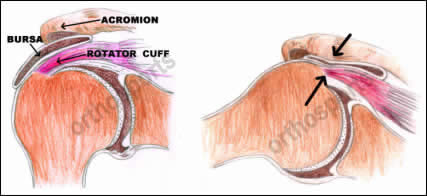Inside This section
Shoulder Impingement
To view an animation of Shoulder Impingement, click here .
There can be many reasons you feel pain when lifting your arm. The most common cause of this pain is called Shoulder Impingement.Other names that are used to describe this condition include… Rotator cuff tendonitis. Bursitis. Supraspinatus tendonitis (one of the rotator cuff muscles).
Impingement pain occurs because the rotator cuff tendon and bursa (see below) are compressed against bone (the acromion) as the arm is elevated. There is inflammation of the Rotator Cuff muscles and tendons and often the adjacent Bursa (which is a lubricating sac). As one lifts the arm, the Bursa and the Rotator Cuff rub on the overlying Acromion bone causing “impingement”.
The most common symptom is pain with movement, particularly elevation and rotation of the arm. It can also occur when loading the shoulder by lifting heavy objects. Patients often complain of loss of motion and power. In more severe cases people experience night pain which disturbs their sleep. The cause of night pain is unknown. The pain is often localised to the upper and outer area of the shoulder and upper arm and may extend (radiate) to the elbow.

Who Gets Impingement?
This condition can occur at any age. It is more common in people who use their arms above their head, particularly for repetitive tasks. It is also more common as you get older because the Rotator Cuff degenerates with age and is therefore more likely to become inflamed. The condition is also more common when the Acromion bone has a hook or spur (but up to 70% of people are born with a hooked Acromion and the majority of them do not have symptoms).
If the condition continues for weeks or months some people notice difficulty moving their shoulder. Occasionally it is very difficult to distinguish between a frozen shoulder and impingement, and early in the disease a frozen shoulder can look exactly like impingement These two conditions are very different and the correct diagnosis must be made because impingement is treated with physiotherapy while a frozen shoulder is not. Shoulder Impingement requires prompt and accurate diagnosis and treatment. If this occurs, it is more likely to have a full and uncomplicated recovery.
Investigations
An x-ray of the shoulder is usually performed. In more complicated cases other tests such as a MRI scans are required. This is especially true if one fails non operative treatment or if a complete Rotator Cuff tear needs to be excluded.
Treatment
Shoulder Impingement responds to non-surgical treatment in most cases and is usually completely reversible.
Treatment includes:
- Anti-inflammatory and pain relief medications.
- Exercises to improve motion and strengthen the shoulder (often with a sports physiotherapist).
- Avoiding aggravating activities.
If the inflammation continues injections of cortisone into the subacromial space are required.
It often takes 3 to 6 months for the symptoms to resolve.
If shoulder impingement fails to improve over 3 to 6 months then surgery may be required. This is usually performed arthroscopically (keyhole or minimally invasive surgery) depending on the extent of the damage and is called an Arthroscopic Acromioplasty. The acromion bone is trimmed to allow more space for the Rotator Cuff to move. Surgery is uncommonly required and only recommended if non operative treatment fails.
Remember
- This condition is completely curable with non operative treatment.
- Physiotherapy is very important.
- Avoid overhead activity and heavy work until symptoms settle.
- Rarely is surgery necessary.
